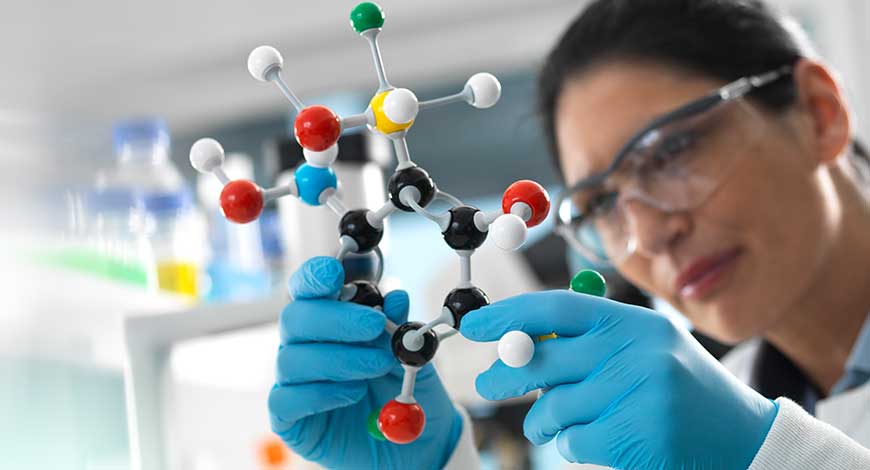Molecular Diagnostics
Molecular diagnostics continues to deliver

The future of medical diagnostics lies in the genomics and proteomics, thereby reassuring the significance and demand for nucleic acid amplification tests in the clinical sector.
Sensitive, specific, and rapid diagnostic tests are critical to reducing morbidity and mortality of infectious disease patients. Viral, bacterial, and other types of infections can develop from a vast number of pathogenic and opportunistic organisms, indicating a need for versatile diagnostics that can be adapted to a wide variety of infectious etiologies. Nucleic acid amplification tests (NAATs) have become a mainstay of diagnostics for infectious diseases. Through amplification and detection of target organism nucleic acids (NAs), NAATs provide highly sensitive detection of pathogens in many different patient samples. Earlier generations of NAATs depend on labor-intensive protocols and bulky equipment that require centralized labs, making it difficult to obtain rapid results, and often impede immediate clinical responses.
However, emerging NAAT technology uses novel protocols with integrated sample preparation, faster amplification and detection methods, and innovative microfluidic designs to support point-of-care testing (POCT) for an array of infectious diseases, including SARS-CoV-2 and globally prevalent sexually transmitted infections (STIs).
These advances support rapid sample-to-answer diagnostics and personalized clinical responses and can, therefore, significantly improve patient outcomes.
Laboratories throughout the developed countries were switching to culture-independent diagnostic testing (CIDTs) as a means for efficient and rapid detection of pathogens. This shift required large investments and new infrastructure guidelines to ensure a unidirectional workflow; separate rooms for reagent preparation, sample preparation, and amplification and product visualization; biosafety cabinets; and various instruments along with consumable items. Developing nations came across substantial monetary investment requirements for NAAT instrumentation, reagents, training facility, and faculty and hence faced a major stumbling block in its routine use in most diagnostic laboratories. This delayed the adoption of NAAT technology by nearly a decade before its ultimate implementation in developing countries through reference laboratories.
Indian market
Currently, molecular genetic methods in Indian clinical diagnostic laboratories are still in their infancy. Besides that, India is lagging behind when it comes to imbibing molecular genetics in clinical practice when comparing to the West or Far Eastern nations. India with over 100,000 diagnostic laboratories, of which 70 percent offer pathology services and 30 percent offer radiology and imaging services, sustains a colossal network of unchecked and unregulated scattered diagnostic laboratories, only 4545 of which are accredited by NABL – a national level quality council board of India. Only the top private corporates in India adopt these rapid technologies for their minuscule advantages, disregarding the constraints that are applicable to a developing country. Worldwide, there are 121 different NAAT-based tests for diagnosis of human diseases and 327 microbial tests for various parameters, approved and listed by the Food and Drug Administration (FDA), yet only a few of these made it into the developing diagnosis markets.
Currently, advanced NAAT techniques and technologies such as PCR, ddPCR, real-time PCR, PCR sequencing, multiplex ligation-dependent probe amplification, amplified fragment length polymorphism (MLPA), GeneXpert, pyrosequencing, and NGS have been successfully employed for clinically relevant applications, such as for screening of infectious and non-infectious diseases, genetic and familial disorders, cardiovascular diseases as well as oncological marker identification, in India. The state-of-the-art private laboratories like SRL Ltd., Dr. Lal PathLabs, Dr. Dangs Lab, Oncquest, and Core Diagnostics, which operate in the northern parts of India utilize high-end high-throughput fully automated technologies, such as Cobas Ampliprep, Cobas Taqman, Abbott MS2000sp, and MS2000rt systems.
Global market
Worldwide market for NAAT is valued at USD 6199.2 million in 2021, and is anticipated to expand at a compound annual growth rate (CAGR) of 12.78 percent from 2022 to 2030. Increase in demand for the advanced rapid diagnostics and rising R&D investments for the development of novel biotechnological diagnostic techniques are the factors fueling the market growth. In addition, high global prevalence of the communicable diseases and need for highly efficient testing alternatives for the successful management of disease outbreaks has propelled demand for the several NAAT technologies. Key players involved in the market have developed new product offerings, such as isothermal nucleic acid amplification technology-based tests, to meet high demand for the rapid testing and point-of-care testing.
As NAAT offers the most precise detection of the target entities, the technique is most commonly used for detection of the infectious agents. The technique has also been extensively studied for diagnostic applications in domains, such as cancer, personalized medicine, and forensics. As a result, a broad range of applications for NAAT are expected to boost the market growth in coming years.
However, nucleic acid amplification methods, such as polymerase chain reaction (PCR), are severely limited by the requirement of thermal cycling and temperature-control instrumentation, which restricts the adoption of PCR technologies in point-of-care applications. This factor can impede the growth of PCR-based technologies and restrict market growth in the near future.
The PCR tests segment recorded the largest market share of 66.68 percent in 2021. The technology enables rapid and sensitive detection of a broad range of target nucleic acid molecules and can be used for the detection of specific pathogens that may be difficult to culture in vitro. In addition, widespread penetration of PCR technology has enabled applications of the technique for the detection, quantification, and genotyping of a variety of bacteria and viruses from several types of clinical specimens, including plasma, serum, semen, cerebrospinal fluid, and others. As a result, the PCR tests segment is expected to witness significant growth.
The isothermal nucleic acid amplification technology (INAAT) tests segment is projected to expand at a rapid CAGR with the introduction of novel technologies, such as loop-mediated isothermal amplification (LAMP), strand displacement amplification, and recombinase polymerase amplification, among others, that are broadening the scope of the applications for nucleic acid-based test products.
The infectious disease segment held the largest market share of 46.16 percent in 2021. The Covid-19 testing sub-segment held the largest share in 2021 within the infectious disease testing segment due to the global presence of the pandemic and the launch of several new PCR tests.
Oncology testing segment is projected to expand at the fastest CAGR with the rise in R&D interests for the development of novel cancer diagnostic alternatives and rapid progress in cancer research. For instance, in March 2022, researchers from Queen Mary University of London announced the development of the first PCR test for the detection of oral cancer. Such advancements are likely to fuel growth prospects for the nucleic acid amplification testing of other ontological conditions in the near future.
The central and reference laboratories segment dominated the market in 2021 due to its extensive testing portfolio and coverage across multiple healthcare settings. In addition, supportive government initiatives are aiding in the expansion of the testing capacities of such laboratories. For instance, in June 2022, the Department of Health and Human Services (HHS) expanded the Monkeypox testing capacity to five laboratory companies, including Lab corp., Quest Diagnostics, Mayo Clinic Laboratories, Aegis Science, and Sonic Healthcare.
Hospitals segment is expected to grow at the fastest CAGR of 13.44 percent by 2030. The rise in healthcare expenditure globally and the increasing role of nucleic acid amplification techniques for disease surveillance and prevention of outbreaks are the factors leading to the growth of the segment. Similarly, growth in hospital testing capacities post-COVID-19 and availability of the high throughput testing capabilities can considerably boost the market prospects for nucleic acid amplification testing.
The NAAT market is highly competitive due to the strategic initiatives adopted by emerging and key players. Several new types of nucleic acid amplification tests have been launched in recent years. Some of the leading players include F. Hoffmann-La Roche Ltd., Becton, Dickinson and Company, Danaher Corporation, Abbott Laboratories, Illumina, Inc., Siemens Healthineers, bioMérieux SA, Novartis AG, Bio-Rad Laboratories, Inc., and See Gene Inc.
Nucleic acid amplification-based methods have proven their clinical relevance in medical diagnostics due to their edge over traditional methods. The low limit of detection, rapid turnaround time, ability to identify culture-independent microorganisms, and specific genetic disorder in a compact and versatile form factor empowered its implementation into diverse fields, such as oncology, pathology, virology, hereditary genetic disorder and syndromes testing, pharmacogenomics, transplantation, and gene expression studies. In conclusion, NAAT is a robust tool in the present-day clinical diagnostic laboratory. Although numerous cutting-edge NAAT technologies exist throughout the globe, accommodation of these into the Indian diagnostics market took enormous resources and time. The influence of multinational diagnostic centers played a crucial role in the adoption of these novel technologies. However, these were confined to major metro cities.
POC to improve diagnostic preparedness
 Heejae Park
Heejae Park
Director–Global Sales Division 1 (Asia Pacific)
Boditech Med Inc.
The decentralization of tests started 20 years back and point-of-care (POC) testing has skyrocketed during Covid-19 as the demand for accurate and fast testing was the need of the hour. The diagnostic test performed outside the central lab is called POC. The POC testing devices have enhanced the diagnostic capacity for several severe diseases and disorders, with the technology’s biggest selling point being its dramatic reduction of turnaround time.
We have innovated the immunofluorescence assay (IFA) technology, which allows to produce a quantitative lab-like quality results quickly that can be transferred automatically to LIS or HIS. We try to address the challenge of getting skilled technologists, which is more severe in Tier-II and Tier-III towns. The IFA platform has come to the rescue of many hospitals and labs as it can be easily operated with minimal training. The immediate test results generated by our i-chroma and AFIAS system have formed the basis of the evidence-based treatment decisions. This has resulted in a large installation base of more than 60,000 installations in more than 130 countries. In India alone, we have 8000-plus i-chroma II installations, it is also due to the active promotion by our business partners.
Numerous factors are stimulating the demand for POC testing. These include the increasing prevalence of infectious diseases and the rising incidences of lifestyle diseases, such as cardiac diseases, diabetes, and auto-immune diseases. Technological innovations like AFIAS provide expedited diagnosis where the patient is seen or in the patient’s home.
Boditech is one of the leaders in POC diagnostics with almost 55-plus tests, which include AFIAS Infliximab, a therapeutic drug-monitoring (TDM) diagnostic kit that measures the blood concentration of drugs for immune-mediated inflammatory disease. This is the first POCT company that has acquired approval of TDM products in South Korea.
Boditech Med Inc. S. Korea has established a 100-percent subsidiary in India called Boditech Med India Private Limited in 2021 to stay closer to the customer.
We are confident that POC diagnostics will be a part of the paradigm shift from curative medicine to predictive, personalized, and preemptive medicine.
On the other hand, NAAT-dependent point-of-care technologies witnessed increasing demand in high disease-burden developing countries like India. Enormous growth of the diagnostic sector in India is contributed by multiple factors, such as demand over healthcare facilities, increasing disease burden along with rapidly growing infection rate, rising awareness for prevention and testing, combined with accessible and affordable diagnostic networks.
RT-PCR to next-generation sequencing (NGS)
 John Mathayi
John Mathayi
Head of Business Development and Marketing,
INDO MEDX
Early to extract DNA, we had assays based on gel electrophoresis, which was time-consuming and prone to false-positive results from contamination. Presently, we have RT-PCR (real-time reverse transcription-polymerase chain reaction assay), which was developed to have high sensitivity, specificity, and quantifiable with rapid detection of the antigen RNA or DNA present in the body. RT-PCR assays are based on detecting and quantifying a fluorescent signal generated during amplification. They do not require post-amplification processing and, therefore, eliminate contamination. The assay, based on multiple primers and probe sets located in different regions of the genome, could discriminate antigens from humans. The real-time RT-PCR assay is more sensitive, rapid, and accurate than a conventional RT-PCR assay, antibody detection, or culture isolation. Real-time PCR has the advantage of being easy to use and more tolerant of variable DNA quality, but has limited multiplex capability.
In contrast to RT-PCR, there is NGS (next-generation sequencing) method that allows simultaneous analysis of many genomic loci while revealing the exact sequence changes. NGS is a high-throughput DNA-sequencing technology, in which billions and millions of DNA strands can be sequenced in parallel, yielding more throughput.
Applications
NGS is performed at transcriptome level for sequencing mRNA, rRNA, and tRNA to study about fusion genes and DNA methylation, for instance, NGS-based fusion detection (hematological carcinoma).
Whole genome sequencing is useful in identifying rare genetic disorders, such as identification of chromosomal disorders (Down Syndrome-T21, Tuner’s Syndrome-X), Edward’s Syndrome-T18).
Targeted panel sequencing is mostly used in specifying mutations that cause different types of cancers. For example, Brca1&2 panel sequencing identifies mutations leading to ovarian and breast cancer.
NGS technologies can be used for mining the SNPs, CNV, InDel at larger scale to understand whether the drugs will produce adverse reactions or not.
NGS is useful in identifying infectious disease more precisely than the classic methods. Whole genome sequencing and amplicon sequencing of rRNA genes in microbes is useful in constructing high-resolution mapping, which upholds the pathogenicity of microbes. For example, novel pathogens, such as SARS-CoV2 and its variants, are identified.
Metagenomics sequencing evaluates bacterial diversity and their abundance in various environments.
INDO-Medx have their own RT-PCR kits, based on Taq Man chemistry for diagnosis of multiple diseases. It is a multiplex assay with single well means multi gene as well as multi disease in a single reaction (SARS Cov2 Assay). INDO-Medx believes in continuous improvements in its products and support in easy diagnostics. Thus, we also develop extraction free kits, which reduce time, cost, risk, and expertise. As there is limitation of RT-PCR assay in respect to mutation detection in genes, INDO-Medx is developing new products for NGS to support in quality diagnosis.
Overall, NAAT-based technologies proved to be sustainable, and heads its path to replace conventional gold standard tests through rigorous evaluation, demonstration, and assessments leading to better test outcomes and positively impacting overall healthcare sector. The future of medical diagnostics lies in the genomics and proteomics, thereby reassuring the significance and demand for NAAT in the clinical sector.












